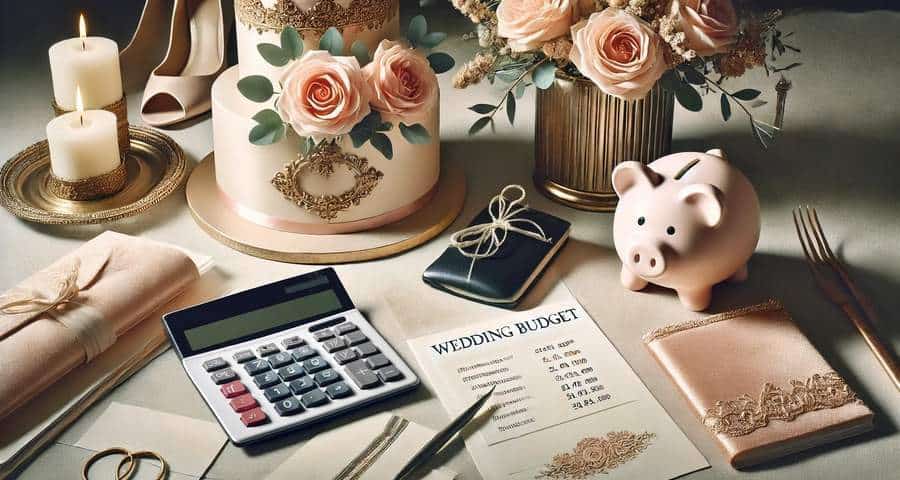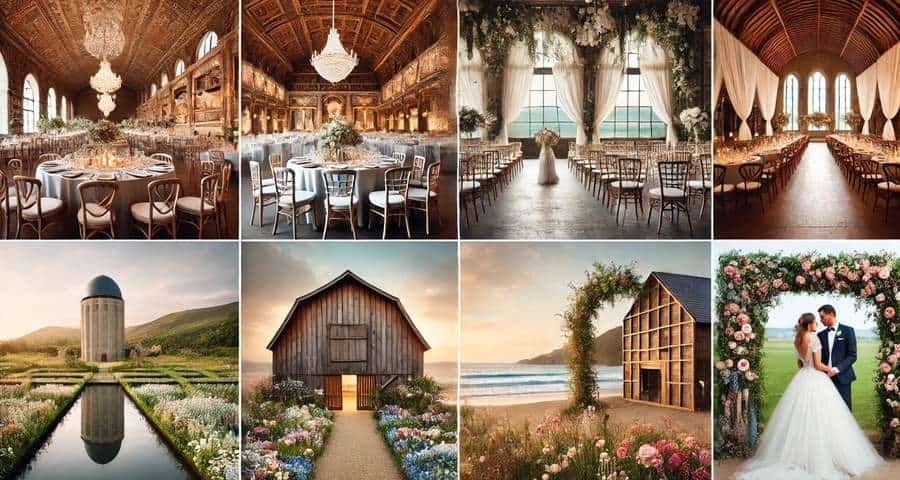Congratulations on your engagement!
But how exactly do you plan a wedding? There’s a good chance that question flashed through your mind once the initial excitement of being engaged subsided and you started to think about what comes next.
Planning a wedding is a monumental task. It’s a large and significant event, and if you’ve never organised something like this before, the process can seem truly overwhelming. Initially, you’re faced with countless decisions and tasks, making it tough to know where to start.
Despite the unique and personal nature of each wedding, there are common steps that most couples need to take when they begin planning their big day. These steps are universal, regardless of individual preferences or circumstances.
The key to making the process manageable and enjoyable is to take it one step at a time, focusing on the most important decisions first and building a strong foundation for the rest of your planning journey.
Step 0: Celebrate Being Engaged

Before you start planning your wedding, take some time to celebrate this amazing milestone!
Being engaged is a special time in your relationship. It’s full of excitement, love, and looking forward to the future.
Share the good news with your loved ones. Enjoy this period and make wonderful memories that you will look back on as you start the journey to your big day.
Remember, planning your wedding should be fun and rewarding, not just a series of tasks to check off.
Step 1: Set a Budget

The first foundational step in planning your wedding is setting a realistic budget.
Begin by assessing your total financial resources, including any savings specifically set aside for the wedding, potential contributions from family members, and other sources of funds you might access.
It’s important to confirm these amounts early in the planning process to avoid any uncertainties later.
Balancing your wedding budget against your other life goals and current financial responsibilities is vital.
Consider how investing in your wedding day will impact your long-term financial goals, such as buying a home or saving for retirement.
This consideration will help you determine the maximum amount you are willing to spend on your wedding without compromising your financial health.
For a more detailed look at how to plan and prioritise your wedding budget effectively, ensuring you cover all necessary expenses without overspending, check out our comprehensive guide: How to Set Your Wedding Budget.
Step 2: Choose a Date Range or Season

The next step is to choose a rough date range or a preferred season. This early decision doesn’t need to pinpoint an exact day but should identify a period that best fits your vision and practical considerations.
Here’s why this approach is beneficial:
- Flexibility with Venues: Selecting a season or a range of months increases your options for venue availability. It allows you to be flexible in negotiations and secure your ideal venue without being constrained by a rigid date.
- Aligning with Vision and Style: Different seasons offer distinct atmospheres and themes. For example, a fall wedding can capitalise on the natural beauty of autumnal colours, while a spring wedding can feature floral themes and outdoor settings.
- Consideration of Guest Availability: Choosing a range, such as “late spring” or “early fall,” helps in considering the availability of crucial guests. It also allows you to check with important family and friends about major conflicts before setting a concrete date.
- Budget Optimization: Some seasons or months might be less expensive due to lower demand. This can align well with your budget, allowing you to allocate more funds to other areas like food, entertainment, or decoration.
- Weather and Comfort: The time of year significantly impacts the weather conditions, which can affect guest comfort and your venue choice. For instance, avoiding the hot summer months or the unpredictable weather of early spring could be strategic decisions based on your location.
By selecting a date range or season early in the planning process, you create a foundational decision that guides the availability of venues, vendors, and the overall ambiance of your event. This approach not only simplifies the subsequent steps but also maximises your options and flexibility as you move forward with planning your perfect wedding.
For a deeper understanding of the different factors that go into choosing the right date range for your wedding, check out my guide on: Finding the Perfect Date for Your Wedding.
Step 3: Draft a Preliminary Guest List

Creating an initial rough draft of your guest list is important as the size of your guest list heavily influences the choice of venue and can significantly impact your budget.
This list is not your final list but should give you a realistic overview of who you might want to invite to get a feel for the number of people you want to invite.
Starting with a broad list allows you to scale down based on venue capacity and budget constraints or expand if additional resources become available.
For more detailed insights into estimating your guest list size and understanding how it affects your wedding planning, be sure to read my guide: How to Estimate Wedding Guest List Size.
Step 4: Create a Vision for your Wedding Day

Your wedding should be a reflection of your love story, personalities, and shared values. Crafting a vision allows you to infuse your celebration with personal touches and meaningful elements that make your wedding truly yours.
By envisioning your ideal wedding, you can identify which aspects are most important to you and your partner. Whether it’s an intimate atmosphere, a stunning location, exceptional food, or personalised details, understanding your priorities helps you allocate your budget and energy more effectively.
Your wedding vision serves as a blueprint for your aesthetic choices, such as colours, decor, attire, and overall theme. Having a clear vision ensures that all these elements work together harmoniously to create the desired ambiance and style.
With the countless decisions you need to make, from choosing invitations to selecting table linens, having a strong vision in mind simplifies these choices. You can always refer back to your overall concept to ensure each decision aligns with your desired outcome.
When you have a defined vision, it also becomes easier to manage expectations—both your own and those of your family and friends. Communicating your vision clearly helps your loved ones understand your priorities and the overall direction of your celebration, facilitating better support and alignment throughout your planning process.
For a more in-depth understanding of how to theme your wedding, check out my guide on Choosing a Wedding Theme: Popular Ideas and Tips.
Additionally, if you’re looking for a step-by-step guide to creating a cohesive vision for your wedding, be sure to read my article on How to Create Your Wedding Vision.
Step 5: Research and Book Your Venue

Booking your venue not only solidifies your wedding date but also allows you to move forward with other planning aspects with confidence, knowing where and when your wedding will take place.
Before finalising your booking, it’s crucial to double-check the availability of your most essential guests, such as immediate family members and the wedding party. Confirming that these key individuals can attend on the proposed dates will save you from potential scheduling conflicts after the venue is booked.
Your venue should reflect the overall vision you have for your wedding. Whether you’re dreaming of a rustic barn, an elegant ballroom, or a cosy beachfront, the venue should complement the style and atmosphere you want to achieve.
Think about the size of your guest list, the location’s accessibility for guests, and the type of services and amenities the venue offers. For example, some venues might offer full-service options that include catering and decoration, while others might only provide the space.
Schedule visits to see the venues firsthand. Pictures and descriptions can be helpful, but seeing a space in person can give you a much better feel for whether it fits your needs and desires.
Once you find a venue that meets all your criteria, check for availability around your preferred date range. Venues can book up quickly, especially popular ones during peak wedding seasons, so it’s important to secure your booking as soon as you make a decision.
Before signing any contracts, make sure you fully understand what is included and what might be additional costs. Negotiate any details if possible, and then secure your venue with a deposit to confirm the booking.
With your venue booked, you can now make more detailed decisions about other aspects of your wedding like the layout, the flow of the ceremony and reception, transportation logistics for guests, and specific decorations that will enhance the venue’s natural appeal.
For a more comprehensive guide on selecting the perfect location for your ceremony, check out my article on Finding the Perfect Wedding Ceremony Venue.
Step 6: Finalising Your Wedding Date

With having your venue booked you can finalise your wedding date, which sets a firm timeline for all your planning activities and allows you to proceed with detailed preparations, knowing that all key participants are aligned.
This step cements the foundation of your wedding planning, ensuring that the day you envision becomes a reality on the calendar and now has a fixed time for when it is going to occur.
Once your date is finalised and all key elements are locked in, you can announce it to all your guests. This can be done through save-the-date cards, digital announcements, or updates to your wedding website. This not only excites your guests but also helps them plan their attendance, especially if travel is involved.

